#QSFP28 AOC
Explore tagged Tumblr posts
Text
#tripp lite#eaton#10m#fiber#qsfp28#aoc#100gb#aqua#univold#cisco#400g#amazon#ebay#walmart#lenovo#nec#cable
1 note
·
View note
Text
Active Optical Cable & Extender Industry worth $6.2 billion by 2028
The report "Active Optical Cable & Extender Market by Product, Protocol (InfiniBand, Ethernet, Serial-Attached SCSI (SAS), DisplayPort, HDMI, Thunderbolt, USB), Form Factor (QSFP, QSFP-DD, SFP, SFP+, PCIE, CXP), Application and Region - Global Forecast to 2028" The active optical cable & extender market size is valued at USD 3.3 billion in 2023 and is anticipated to be USD 6.2 billion by 2028, growing at a CAGR of 13.1% from 2023 to 2028.
The key factors contributing to the growth of the active optical cable & extender market include the requirement for fiber optic modules in data centers and the large-scale adoption of cloud-based services. The acceptance of big data and analytics software is also a key factor driving the active optical cable & extender market. AOCs are deployed within data centers to optimize the existing infrastructure by providing higher data rates among servers, switches, and storage facilities. Cloud computing services require high bandwidth, processor speed, and I/O. Active optical cables are used for various cloud computing applications to meet these demands.
The extenders segment holds the second highest market share of the product segment.
Extender plays a crucial role in modern data transmission and telecommunications networks. As data rates and bandwidth demands continue to escalate, the need for reliable and high-speed connectivity over longer distances has become paramount. Extender addresses this requirement by utilizing optical fibers to transmit data signals over much greater distances than traditional copper cables. The extenders enable seamless communication between data centers, buildings, campuses, and across geographical locations, making them an essential component in an interconnected world.
InfiniBand to hold the largest share of the market in 2022.
InfiniBand is an industry-standard specification with a roadmap defining increasing speeds. It interconnects servers, communications infrastructure equipment, storage, and embedded systems. It provides switched, point-to-point channels with data transfers of up to 600 gigabits per second. Established and governed by the InfiniBand Trade Alliance (IBTA), InfiniBand technology is a prominent networking solution in supercomputer clusters. This technology has also become the preferred network interconnection method for GPU servers, particularly with the growing influence of AI applications.
QSFP-DD segment to exhibit second-highest CAGR between 2023 and 2028.
QSFP-DD (quad small form-factor pluggable double density) is a transceiver module designed to meet the escalating demand for high-speed data transmission in modern networking and data communication environments. The QSFP-DD module incorporates more electrical lanes and higher data rates than QSFP28. This module leverages eight lanes capable of supporting data rates of 25 Gbps or 50 Gbps, resulting in an aggregate data rate of up to 400 Gbps. This significant enhancement in data capacity positions QSFP-DD as an ideal solution for bandwidth-intensive applications, such as cloud computing, data centers, and emerging technologies, including 5G networks and artificial intelligence.
North America to hold the second-largest share of the active optical cable & extender market during the forecast period.
In North America, AOCs and extender cables are widely used for various applications, including data centers, energy, and telecommunications, to provide advanced connectivity solutions. AOCs are vital conduits for high-speed data transmission, enabling fast communication and efficient networking in sectors such as telecommunications and data centers. They support the growing demand for fast and reliable internet connectivity, facilitating seamless video streaming, online gaming, and business operations.
On the other hand, extender cables are crucial in sectors such as manufacturing and energy, where they bridge communication gaps between remote equipment and control centers. They facilitate efficient data transmission from renewable energy sources and bolster security and surveillance systems in critical infrastructure protection and defense. As North America continues to drive technological innovation, AOCs and extender cables are pivotal in enhancing connectivity and data transmission, contributing to the region’s economic growth and technological advancement. Moreover, top active optical cable companies, such as Broadcom (US), 3M (US), Coherent Corp (US), and Corning Incorporated (US), are headquartered in North America.
Download PDF Brochure: https://www.marketsandmarkets.com/pdfdownloadNew.asp?id=138597811
Coherent Corp.(US), Broadcom (US), Amphenol Communications Solutions (US), Corning Incorporated (US), TE Connectivity (Switzerland), 3M (US), Molex (US), Sumitomo Electric Industries Ltd.(Japan), Dell Inc.(US), Eaton (Ireland), EverPro Technology Co., Ltd. (China), Alysium-Tech GmbH (US), Mobix Labs Inc. (US), Unixtar Technology, Inc. (Taiwan), IOI Technology Corporation (Taiwan), GIGALIGHT (China), Siemon(US), Koincable (China), Black Box (US), ATEN INTERNATIONAL Co., Ltd. (Taiwan), T&S Communication Co, Ltd. (China), ACT(Netherlands), APAC Opto Electronics Inc. (Taiwan), Shenzhen Sopto Technology Co., Ltd., (China), Anfkom Telecom (China), Extron (US), and Roctest (Canada) are the major players in active optical cable & extender market. These players have implemented various strategies to extend their global reach and enhance their market share.
About MarketsandMarkets™
MarketsandMarkets™ is a blue ocean alternative in growth consulting and program management, leveraging a man-machine offering to drive supernormal growth for progressive organizations in the B2B space. We have the widest lens on emerging technologies, making us proficient in co-creating supernormal growth for clients.
The B2B economy is witnessing the emergence of $25 trillion of new revenue streams that are substituting existing revenue streams in this decade alone. We work with clients on growth programs, helping them monetize this $25 trillion opportunity through our service lines - TAM Expansion, Go-to-Market (GTM) Strategy to Execution, Market Share Gain, Account Enablement, and Thought Leadership Marketing.
Built on the 'GIVE Growth' principle, we work with several Forbes Global 2000 B2B companies - helping them stay relevant in a disruptive ecosystem.Our insights and strategies are molded by our industry experts, cutting-edge AI-powered Market Intelligence Cloud, and years of research.The KnowledgeStore™ (our Market Intelligence Cloud) integrates our research, facilitates an analysis of interconnections through a set of applications, helping clients look at the entire ecosystem and understand the revenue shifts happening in their industry.
To find out more, visit www.MarketsandMarkets™.com or follow us on Twitter, LinkedIn and Facebook.
0 notes
Text
QSFP Cable and Connectors Assemblies
A quad (4-channel) Small Form-factor Pluggable Optics Transceiver is also known as a QSFP cable. For applications requiring 40 Gigabit Ethernet (40GbE) data transfers, it is a small, hot-pluggable fiber optical transceiver. They are often used for the implementation of 40G Ethernet, Infiniband, and other communications protocols in data centers.
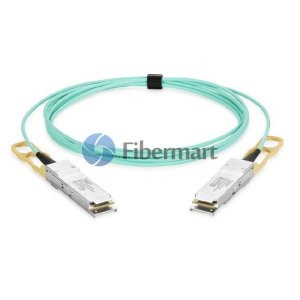
It connects a fiber optic or copper cable to network equipment, such as a switch, router, media converter, or similar device.
In addition to copper cable media, QSFP+ optic transceivers are made to support Serial Attached SCSI, 40G Ethernet, 20G/40G Infiniband, and other fiber optic communication standards. In comparison to SFP+ optic modules, the QSFP28 cable significantly increases port density by 4x.
Optical transceivers are compact, strong devices that add fiber ports to switches or other networking equipment by connecting them to copper or fiber optic cables. Data is transmitted using optical fiber in conjunction with fiber optics in the form of light pulses that travel at very high speeds and can cover very long distances. The transceiver, which is a laser with a certain wavelength that transforms electrical signals into optical signals, is a crucial part of the fiber optic network. The data is then converted into a signal with a specific wavelength by the transceiver and sent over the optical fiber. Wideband signals are those that are 850 nm, 1310 nm, and 1550 nm in wavelength. Narrow bands are the term for CWDM or DWDM signals. Each channel is unable to interact with the others due to the special property of light.
This indicates that a network can handle the transmission of both wideband and narrowband signals. Direct attach copper (DAC), active optical cables (AOC), optical modules, and active copper cables are all types of QSFP interconnects (ACC). The least costly choice is DACs. They offer a connection that depends on host signal processing. The maximum length that can be achieved depends on the cable assembly's insertion loss, which is determined by its length and cable gauge and is guided by the IEEE specifications (see below) (AWG). The AWG of a wire has an inverse relationship with its size. AWG and wire diameter for QSFP cable assemblies are plotted in the table below.

Follow our Facebook and Twitter for more information about our product.
2 notes
·
View notes
Text
Data Center Cabling Solution: Active Optical Cable
As data rates rise and data center grows in size, copper cable is getting stretched to its limits. However, active optical cable (AOC) has emerged to replace copper cable in data centers and high-performance computing (HPC) applications. It provides high-speed, high reliability, high flexibility, and low power consumption. This article will provide some knowledge of AOC cable.
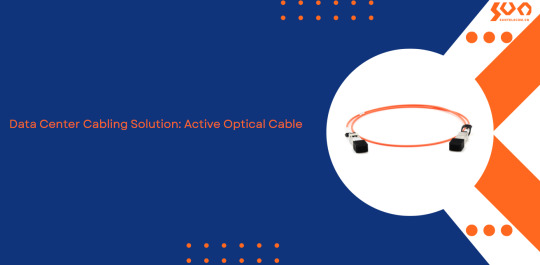
What is an Active Optical Cable?
Active optical cable (AOC) is an optical fiber jumper cable terminated with optical transceivers on both ends. It uses electrical-to-optical conversion on the cable ends to improve the speed and distance performance of the cable without sacrificing compatibility with standard electrical interfaces.
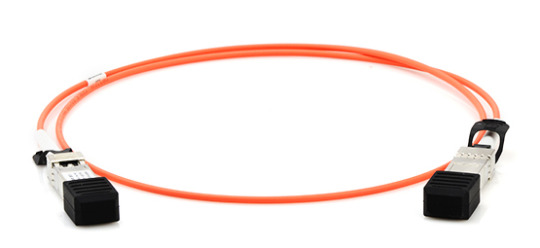
Active Optical Cable Structure
AOC cable consists of the fiber optic connector and fiber cable. The connection between fiber cable and fiber optic connectors is not separable. If the fiber optic connector or fiber cable needs to be changed, they should be removed together. The electrical and optical signal conversion can be achieved right through each end of the optical fiber.
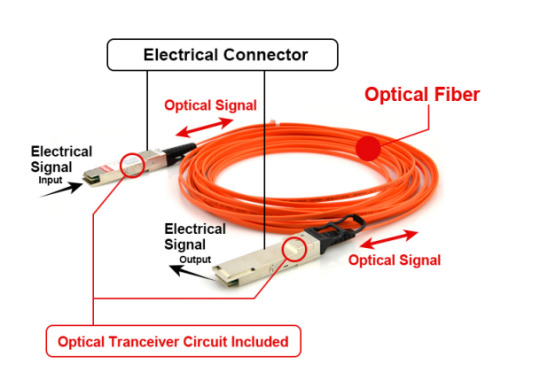
Active Optical Cable Types
There are several varieties of AOC cable available on the market , including 10G SFP+ AOC, 25G SFP28 AOC,40G QSFP+ AOC, 56G QSFP+ AOC, 40G QSFP+ to 4x SFP+ breakout AOC, 40G QSFP+ to 8x LC breakout AOC, 100G QSFP28 AOC, 100G QSFP28 to 4x SFP28 breakout AOC and 120G CXP AOC, etc. These AOC cables are commonly used for short-range multi-lane data communication and interconnect applications between two devices, such as rack-to-rack, shelf-to-shelf interconnect, storage, hubs, switches, routers, servers, etc.

Features and Benefits
AOC cable provides low power consumption, high density, high speed, high reliability, high security, small size, strong heat dissipation, low electromagnetic interference, long transmission distance, low energy consumption, low latency, lightweight, and ease of installation.
Application Scenarios
AOC Cable is used to connect top-of-row (ToR) switches to end-of-row aggregation switches, and to connect the ToR switch with storage subsystems at reaches greater than direct attach copper (DAC) limits of 3-7 meters. The following three scenarios show the specific applications.
Scenario 1: AOC cable is used to connect two switches directly.

Scenario 2: The breakout AOC cable provides a highly cost-effective way to connect within racks and across adjacent racks. The following figure shows 40GbE QSFP+ to 4 x SFP+ AOC cable connecting to a 40G QSFP+ port switch on one end, and to four 10G SFP+ port switches on the other end.
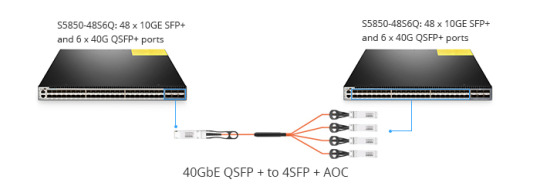
Scenario 3: For the long-haul transmission between the two switches, a suitable solution is recommended to use single-mode patch cable, OEO converters, and AOC cables, which can provide seamless integration of different fiber types by converting multi-mode fiber to single-mode fiber.
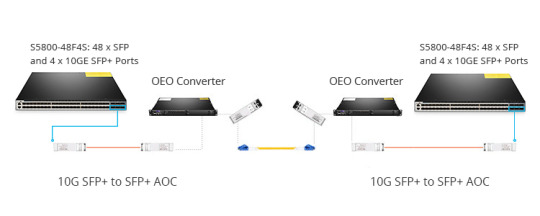
Conclusion
AOC cable achieves high data rates over long reaches interconnection, which is the best solution for data centers and high-performance computing applications. Sun Telecom specializes in providing one-stop total fiber optic solutions for all fiber optic application industries worldwide. Contact us if any needs.
2 notes
·
View notes
Text
The Most Economical QSFP28 AOC and Switch Solution for 100G Network
Nowadays, most users choose to deploy 10G and 40G network that perform highly and efficiently in their systems. It cannot be denied that the bandwidth and capacity the 10G and 40G network provide are enough for their needs at present. However, due to the fast developing Ethernet network technology, the scale and traffic of Internet is rapidly expanding that will make the 10G and 40G network gradually obsolete and unsuitable for data centers, especially for the large-scale ones. Along with this trend, there is no doubt that the 100G network will become the mainstream in the near future. Are you now ready for the 100G network? Or still hesitating because of the high cost? In this paper, it will introduce some 100G QSFP28 AOC and switch solutions that can help you seek the most economical one to upgrade your system from 10G/40G to 100G.

100G QSFP28 AOC Solutions
QSFP28 AOC is a cost effective cable solution for 100G short distance transmission that consists of an OM4 multimode cable and two QSFP28 connectors, supporting 100G QSFP28 standards and compliant to the QSFP MSA (multi-source agreement). The length of the cable is usually available from 1 to 30 meters and its two QSFP28 connectors are fitted at each end of the OM4 multimode cable, very convenient for inserting into and removing from 100G QSFP28 ports. In data center, the QSFP28 AOC is really a low power alternative for 100G short distance transmission, which is highly recommended for the simplified intra rack and inter rack configurations. To seek the most economical QSFP28 AOC solution, the figure below shows the prices of several famous brands of QSFP28 AOC for your reference.

100G Switch Solutions
100G switch is an improved kind of network device designed for data center that offers the signal lane for any two 100G network nodes inserted into its ports. With the popularity of 100G network, it can be also available on many famous fiber optic manufactures like Cisco, Arista, Juniper, as well as the fiber optic manufacture FS.COM. With the aim of looking for a more economical 100G switch solution, the following will mainly introduce Cisco Nexus 3232C, Arista 7500R, Juniper QFX5110 and FS.COM S5850-48S2Q4C, both of which are fitted with QSFP28 ports to support QSFP28 AOCs.
The first type of switch–Cisco Nexus 3232C is a typical kind of low latency and high-performance 100G switch that can not only fulfill our current network needs but also suit for future applications such as big data, cloud and virtualization. And all its 100G QSFP28 ports can operate at 10, 25, 40, 50 and 100 GbE. The second type–Arista 7500R switch, including 7500R-36CQ, 7500R-36Q and 7500R-48S2CQ, is designed to lower power per 100GbE port and produce more reliable and dense network, which are available in a compact system design of 12, 8 and 4 slot. The third type–Juniper QFX5110 can be simply divided into QFX5110-48S and QFX5110-32Q, both of which have 100G QSFP28 ports to support QSFP28 AOC. All these three kinds of 100G switches are very expensive which can be learned from the following figure.
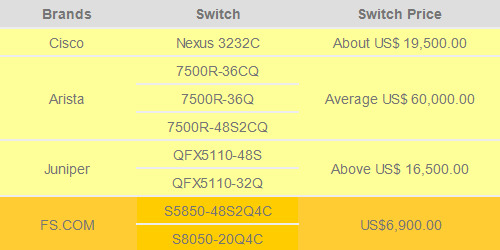
Compared to the previous three types, 100G switches like S5850-48S2Q4C and S5850-20Q4C provided by FS.COM can be available at a much lower cost. In details, the S5850-48S2Q4C has 48x10GbE SFP+ ports, 2x40GbE QSFP+ ports and 4x100GbE QSFP28 ports, while the S8050-20Q4C has 2x40GbE QSFP+ ports and 4x100GbE QSFP28 ports. Both of them are the cost effective switch solutions for building 100G network.
Discussion and Conclusion
From the text above, it can be easily learned that using Arista QSFP28 AOC and switch to deploy the 100G network would cost the most that can be as high as US$ 63,000.00, while the QSFP28 AOC and switch solution provided by FS.COM would be the most economical one, available at a quite low cost usually from US$ 7,440.00 to US$ 7,530.00. Considering that, you are recommendable to use the FS.COM QSFP28 AOC and switch solution for building your 100G network. If you have already had the switch like Cisco, Arista or Juniper, you are also suggested to choose FS.COM compatible QSFP28 AOC that has been tested to assure 100% compatibility, as a much more cost-effective cable solution.
0 notes
Text
Spend Less on Building 100GbE Network With QSFP28 AOC
Currently 10GbE and 40GbE network are efficient and enough for some users. However, to some large-scale data centers, 40GbE Internet speed can’t meet their demands as the Internet continues to grow in size and traffic. According to research predicts, global data center Internet protocol traffic will grow by 31% every year within next five years. So 100GbE technology will become the mainstream in the near future. Cisco, Juniper, Arista provide 100GbE switches, routers and supported QSFP28 transceiver, QSFP28 AOC. But many enterprises still can’t upgrade to 100GbE network since the switch and QSFP28 AOC are quite expensive. Don’t worry about the high cost. This article will help you find a way to spend less on building 100GbE network with QSFP28 AOC.

QSFP28 AOC
100GbE QSFP28 AOC is composed of an OM4 multimode cable connecting two QSFP28 connectors on each end. The form factor design is easy for plugging and removal. The QSFP28 AOC is compliant to the QSFP MSA (multi-source agreement). QSFP28 AOCs support 100G QSFP28 standards and are available in various lengths (usually from 1-30 meters). 100G QSFP28 AOCs provide an affordable low-power alternative to interconnect 100G QSFP28 ports in data center applications. It’s useful for simplified intra rack and inter rack configurations. The following table lists 100GbE QSFP28 AOC of several famous brands.

Switches Supporting QSFP28 AOC
Cisco, Arista, Juniper are three famous fiber optic transceiver manufactures. Transceiver modules and switches of these brands are very common in the market. As the demand for 100GbE data center keeps moving, these manufactures produce switches including 100GbE QSFP28 ports. Here I list four switches which can support QSFP28 AOC, Cisco Nexus 7700, Arista 7500R, Juniper QFX5110 and FS.COM S5850-48S2Q4C.
Cisco Nexus 3232C—The Cisco Nexus 3232C switch is a low latency, dense, high-performance 100GbE switch designed for data center. It can not only meet customers’ current network needs but also suitable for future applications such as big data, cloud and virtualization. Each of 32 100GbE QSFP28 ports can operate at 10, 25, 40, 50, 100 GbE.
Arista 7500R—Arista 7500R switches (7500R-36CQ, 7500R-36Q, 7500R-48S2CQ) is designed to lower power per 100GbE port and produce more reliable and dense network. The switches are available in a compact system design of 12, 8 and 4 slot. 7500R-36CQ has 36-port 100GbE QSFP line card. 7500R-36 owns 1/10GbE line card with two 100GbE QSFP28 ports. 7500R-48S2CQ is available with up to 6 100GbE QSFP28 ports.
Juniper QFX5110—Juniper provides two switches with 100GbE port: QFX5110-48S and QFX5110-32Q. QFX5110-48S is a 10GbE/100GbE data center access switch offering 48x10GbE SFP+ port and 4x100GbE QSFP28 ports. QFX5110-32Q offers up to 32x40GbE QSFP+ ports, or 20x40GbE QSFP+and 4x QSFP28 ports.
FS.COM offers two switches for 100GbE network: S5850-48S2Q4C and S8050-20Q4C. S5850-48S2Q4C provides 48x10GbE SFP+ ports, 2x40GbE QSFP+ ports and 4x100GbE QSFP28 ports. S8050-20Q4C has 2x40GbE QSFP+ ports and 4x100GbE QSFP28 ports.

Spend Less With FS.COM Switches and QSFP28 AOC
Based on Table 1 and Table 2, to build a 100GbE network with QSFP28 AOC will cost a lot, especially when you require for products from Cisco, Arista and Juniper manufacturers. By comparison, you can see the price of FS.COM switches for 100GbE network and QSFP28 AOC is quite lower. So FS.COM can help you spend less on building 100GbE network with QSFP28 AOC. But if you have already owned Cisco, Arista or Juniper switches, you can buy compatible QSFP28 AOCs which are more cost-effective and have been tested to assure 100% compatibility.
Originally published at www.fiber-optic-equipment.com
0 notes
Text
QSFP28 Transceiver: Making the Switch to 100G Network
As data centers around the world explore their options for increasing network speeds and bandwidth, 10G has been a traditional favorite, and 40G is not able to keep pace with the requirements. In this case, 100G network appears to be a preferable option to accelerate data flow for those bandwidth-hungry applications. QSFP28 transceiver module hence becomes the universal data center form factor for 100G optical transmission. This article will address the necessity of 100G network, while illustrating QSFP28 transceiver modules used in 100G transmission.
100G: The Optical Revolution in Data Centers
The 100G adoption rate in optical landscape is consistently on the rise for the past few years. It is predicted that over half of the data center optical transceiver transmission will make the shift to 100G. The traditional 10G or even 40G may not be enough considering the explosion of data, therefore, 100G is going to become the new standard, and it has the following advantages.

Cost Efficiency—100G now delivers a compelling price point, offering far greater capacity increases for the cost. And it still future-proofing the network with unsurpassed bandwidth.
Proactive Scale—100G offers the expansion and scalability to support the reliability, manageability and flexibility demanded of modern networks while preparing data centers for future bandwidth and speed requirements.
Speed and Capacity—10GG optical transport will not be enough for data intensive industries. Thus 100G is specifically designed to transport enormous amounts of data with ultra-low latency.
Flexibility—100G will be the preferred technology across long-haul networks. 100G networking can be customized, optimized, and easily expanded to allow for changes in the future.
Cost Decrease—The market transition to 100GE is now in full force. The growth in 100G deployments will undoubtedly drive down the cost of 100G transceiver modules.
100G QSFP28 Transceiver Unravel
QSFP28 transceiver generally has the exact same footprint and faceplate density as 40G QSFP+ . Just as the 40G QSFP+ is implemented using four 10Gbps lanes, the 100G QSFP28 transceiver is implemented with four 25-Gbps lanes. With an upgrade electrical interface, QSFP28 transceiver is capable of supporting signal up to 28Gbps signals. Though QSFP28 transceiver keeps all of the physical dimensions of its predecessors, it surpasses them with the strong ability to increase density, decrease power consumption, and decrease price per bit. The Following are some QSFP28 transceivers for different applications.

QSFP28 100GBASE-SR4
100G QSFP28-SR4 came out firstly to support short distance transmission via multimode fiber. This transceiver module can support 100G transmission up to 70m on OM3 MMF and 100m on OM4 MMF. With MTP interface, the 100G QSFP28-SR4 module enables 4×25G dual way transmission over 8 fibers.

QSFP28 100GBASE-LR4
100G QSFP28-LR4 is specifically designed for long distance transmission. The module utilizes WDM technology for 4×25G data transmission, and these four 25G optical signals are transmitted over four different wavelengths. With a duplex LC interface, the 100G QSFP28-LR4 module enables 100G dual-way transmission up to 10 km over single-mode fiber.

QSFP28 100GBAS-PSM4
PSM4 uses four parallel fibers (lanes) operating in each direction, with each lane carrying a 25G optical transmission. It sends the signal down to eight-fiber cable with an MTP interface. The operating distance of 100G QSFP28-PSM4 is limited to 500 m.

QSFP28 100GBASE-DWDM4
DWDM4 uses WDM technology—an optical multiplexer and de-multiplexer to reduce the number of fibers to 2. It can operate on single-mode fiber up to 2 km over duplex LC interface. Compared with QSFP28-LR4, it has shorter transmission distance and lower cost.

100G QSFP28 Cables
In addition to the QSFP28 transceiver modules mentioned above, cables can also be deployed in 100G transmission. The cables can be either direct-attach copper cables (DACs), or active optical cables (AOCs). QSFP28 DACs offer the lowest cost but are limited in reach to about 3 m. They are typically used within the racks of the data center, or as chassis-to-chassis interconnect in large switch and routers. QSFP28 AOCs are much lighter and offer longer reach up to 100 m and more.
Frequently Asked Questions About QSFP28 Transceiver
What Is the Difference Between QSFP28 Transceiver and QSFP+?
These two have the same size form factor and the number of ports, however the lane speeds of QSFP28 transceiver are increased from 10 Gbps to 25 Gbps. The increase in density is even more dramatic when compared to other 100Gbps form factors: 450% versus the CFP2.
How Many QSFP28 Transceiver Moduels Can Fit into One Switch?
With QSFP28 transceiver, a one rack-unit (RU) switch can accommodate up to 36 QSFP28 ports. While many more varieties of transceivers and cables (DACs and AOCs) can plug into these ports.
Conclusion
100G QSFP28 transceiver offers direct compatibility with your existing switches and routers, and it facilitates the process of scaling to 100G networks with the simplicity as 10G networks. With higher port density, lower power consumption and lower cost, QSFP28 transceiver is an ideal alternative for large scale data centers, as well as future network expansions. All the QSFP28 transceiver modules presented in this article are available at FS.COM. For more details, please visit www.fs.com.
Source: http://www.fiber-optic-solutions.com/qsfp28-transceiver-making-switch-100g-network.html
0 notes
Text
Approved Networks Releases 100G QSFP28 Universal Transceiver
by Scott Mortenson

Approved’s New QSFP28 Universal Transceiver Provides an Alternative Solution for Multi-Mode LC and Single-Mode CDWM4 Environments
Lake Forest, California (December 1, 2022): Approved Networks, a brand of Legrand, the industry leader and authority in programming, testing, and distribution of quality third party optics, announced today the addition of 100GBASE QSFP28 Universal transceiver for both multi-mode and single-mode applications.
The QSFP28 Universal provides an alternative solution for 100G multi-mode Lucent Connector environments, with the added feature of compatibility with single-mode CDWM4 optics up to 2km.
“Existing multi-mode LC solutions are difficult to source – up to 40 weeks in some cases – and they’re more expensive,” said Brian Patton, VP, Engineering, Approved Networks. “Our universal solution not only costs less, but is in stock, and offers the single-mode interoperability that no other multi-mode LC solution has.”
The QSFP28 Universal transceiver is part of a deep and diverse family of optical devices from Approved Networks, including Direct Attach Copper, Active Optical Cables, Active Electrical Cables, and passive WDM solutions. The QSFP28 Universal joins an extensive line of transceivers for Enterprise Data Centers, Managed Services Data Centers, Colocation Data Centers, and Cloud Data Centers.
Find out more about the QSFP28 Universal here.
About Approved Networks, a brand of Legrand
Approved Networks, a brand of Legrand in the Data, Power, and Control Division, provides cost-effective, high-performance optical solutions to a global network of Fortune 500 Enterprise, Data Center, and Service Provider partners. For over 30 years, Approved has been the industry authority on OEM alternative optical networking connectivity through a commitment to technical engineering, stringent quality standards, extensive testing capabilities, and dedicated customer service and support – before, during, and after deployment. Over 10,000 customers in more than 40 countries trust Approved Networks transceivers, DACs, AOCs, and passive solutions to light their networks. https://www.approvednetworks.com
About Legrand
Legrand is the global specialist in electrical and digital building infrastructures. Its comprehensive offering of solutions for commercial, industrial and residential markets makes it a benchmark for customers worldwide. The Group harnesses technological and societal trends with lasting impacts on buildings with the purpose of improving life by transforming the spaces where people live, work and meet with electrical, digital infrastructures and connected solutions that are simple, innovative and sustainable. Drawing on an approach that involves all teams and stakeholders, Legrand is pursuing its strategy of profitable and responsible growth driven by acquisitions and innovation, with a steady flow of new offerings—including products with enhanced value in use (faster expanding segments: datacenters, connected offerings and energy efficiency programs). Legrand reported sales of €7.0 billion in 2021. The company is listed on Euronext Paris and is notably a component stock of the CAC 40 and CAC 40 ESG indexes. (code ISIN FR0010307819). https://www.legrand.us/
0 notes
Text
Answers to frequently asked questions about optical modules
Optical module is an optoelectronic device for photoelectric and electro-optical conversion. The transmitting end of the optical module converts the electrical signal into an optical signal, and the receiving end converts the optical signal into an electrical signal. This article will answer the common questions about optical modules in optical communication.
1. What does passive and active module mean?
The passive and active modules are for AOC high-speed cable and DAC copper cable. The AOC module is equipped with laser, detector, MCU, driver chip, transimpedance amplifier and limiting amplifier, so it is an active cable; Similarly, ACC copper cable module is also an active cable with signal equalization and amplification chip, EEPROM, resistance, capacitance, inductance and copper wire. The DAC copper cable has no signal equalization and amplification chip, only EEPROM, resistance, capacitance, inductance and copper wire, so it is a passive cable.
From the perspective of circuit properties, passive devices have three basic characteristics: 1)They either consume electric energy or convert electric energy into different forms of other energy. 2)Just input the signal and can work normally without external power supply. 3)Common passive electronic devices passive devices in electronic systems can be divided into circuit devices and connection devices according to their circuit functions.
2. Issues related to FEC function of 25G/40G/100G optical module
FEC is an error correction technique that solves the problem in optical signal transmission when part of the optical signal at the transmitting end is scrambled during transmission, resulting in a misjudgment at the receiving end. Forward Error Correction (FEC) is used in 100G and other high-speed optical modules. Generally speaking, when this function is turned on, the transmission distance of the high-speed optical module will be longer. 10G and below 10G optical modules, 40G optical modules, 100G LR4 optical modules do not need to open FEC; 25G SR, 25G LR, 25G AOC, 25G copper, 100G SR4, 100G PSM4, 100G AOC, 100G CWDM4, 100G QSFP28 ER4, 100G 4WDM-40, 100G copper cable need to open FEC.
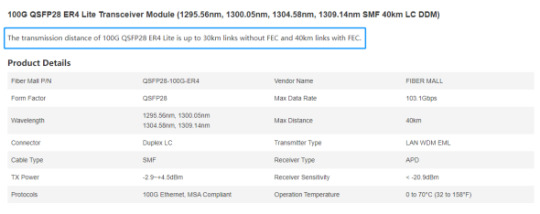
3. Why some optical modules can be divided into four channels and some can't?
MPO interface optical modules all can be divided into four channels, such as: 40G-QSFP-SR-MM850, 40G-QSFP-LSR-MM850, QSFP28 SR 100G MM850 multimode optical module, 40G-QSFP-LR4-PSM-SM1310, 100G-QSFP-iLR4-PSM-SM1310 single-mode Optical modules; the above 40G/100G optical modules work the same, are 4x10G, 4x25G design scheme, using a point four fiber patch cable, one end of the MPO 12 interface is 8 cores (4-way transmit, 4-way receive, the middle 4 idle), the other end of 8 LC connectors.
4. What are the parameters of the optical module? What do they mean?
The main parameters of optical module include rate(bandwidth), transmission distance, central wavelength and interface type.
The DDM monitoring parameters of optical module digital diagnosis include working voltage, shell temperature, bias current, TX power and Rx power; The signal quality parameters of optical module include transmitted optical power, extinction ratio, transmitted optical eye diagram, jitter, margin, received optical power, received sensitivity, output electric eye diagram and bit error rate.
The manufacturer burns the identification code in the optical module register according to the protocol. The switch software accesses the optical module register according to the protocol rules, then identifies the optical module and issues the configuration.
5. What’s the difference of 40G and 100G optical module?
The interface type of 40G/100G optical module is the same as the communication principle, and the single-mode optical fiber used is the same. The multi-mode optical fiber grade OM2 and above is required for 40G multi-mode optical module, while the multi-mode optical fiber grade OM3 and above is required for 100G multi-mode optical module; For 40G-QSFP-SR-mm850, 40G-QSFP-LR-mm850 and 100G-QSFP-SR-mm850 optical modules, it is required to use "MPO/MTP-PC-Female - MPO/MTP-PC-Female, multi-mode, OM3-300, 12 core, Φ 3.0mm, LSZH, water blue, B-type" optical fiber jumper.

Fiber Mall 100G QSFP28 SR optical transceiver
6. How does BIDI type module achieve using only one fiber?
Usually, optical modules have two different fibers for transmitting and receiving.
Bidi (BI direction): in the same optical fiber, two optical signals with different wavelengths are used to transmit and receive optical signals in two directions respectively, and a prism is used inside the module to distinguish the optical signals in two directions. For example, like QSFP28 100G SRBD, since the laser wavelengths sent by the modules at both ends are inconsistent, pay attention to pairing when using Bidi modules.
7. What are the types and construction principles of optical fibers?
The optical fiber is a very fine white glass core, which must be covered by several layers of protective structures before use. The coated cable is an optical cable. Fiber types are divided into single-mode fiber and multimode fiber.
Differences between single-mode and multimode fibers:
1) Single mode fiber uses solid-state laser as light source, and multi-mode fiber uses light-emitting diode as light source;
2) Single mode fiber has long transmission frequency bandwidth and transmission distance, but needs laser source, which has high cost, low transmission speed, short distance and low cost of multi-mode fiber;
3) The core diameter and dispersion of single-mode fiber are small, and only one mode transmission is allowed;
4) Multimode fiber has large core diameter and dispersion, allowing hundreds of modes of transmission;
5) Multimode optical cable has a thick core and the price will be relatively expensive.
0 notes
Text
25G Switch Comparison: How to Choose the Suitable One?
Driven by the undeniable growth in demand for bandwidth of private and public cloud data centers, 25G Ethernet over a single lane has become the new trend for sever-to-switch interconnections. And the increasing requirements of higher speeds in data centers have enhanced the adoption of 25G switch, which is the new buzz in recent years. In this post, a simple analysis of 25G switch market and comparison of commonly used 25G switches will be explored.
25G Switch Market Analysis
As we know, before 25G technology advent, the existing options are one lane for 10G, four lanes for 40G, or four lanes at 25Gbps for 100G. The 25G technology meets the specification for existing module form factors like SFP28 and QSFP28, and allows for a breakout connection between 25G and 100G without changing the port on the front of many 100G switches. Besides, driven by the high speed and bandwidth, various switch manufacturers have announced their new 25G switches in recent three years, just to occupy more market shares.
Cisco delivered their Nexus 9300-FX platform switches for 10G/25G/100G switching;
Mellanox launched 25G Ethernet switch SN2410 series for 25G/50G/100G Ethernet networks;
Dell put forward EMC networking S-series 25/40/50/100GbE to help data centers migration;
Broadcom announced its BCM56960 Series 25G switch for cloud-scale networking;
FS.COM introduced N-Series spine/leaf 25G/100G switch for cost-effective data center solutions.
At the same time, 25G optical transceivers, DACs, and AOCs also spring up like mushrooms. According to a study by Dell’oro, Ethernet switch revenue will continue to grow through the end of the decade, with the biggest sales forecast for 25G and 100G ports.

Notes: the source of the research: Crehan research.Inc
From the research we can see, at least in the next three years, 25G/50G/100G bandwidth will continue to grow and occupy half of the total network bandwidth, which in turn enhances the development of 25G switch market. Though challenges still exist for 25G Ethernet, it’s not denied that the trend for ToR 25G switches cannot be blocked.
Comparison Between Commonly Used 25G Switches in the Market
As have mentioned above, 25G switch market is booming due to the growing speed and bandwidth as well as switch vendors promotion. Then how to achieve the optimized network performance with existing 25G Ethernet switches, and control the total investment at the same time? Firstly, let’s have a look at the 25G switches in the market.

All the 25G SFP28 switches listed in the table have the same port configuration: 48 SFP28 ports and 6 QSFP28 uplink ports. And there are ToR/Leaf switches. Usually 25G switch is often used for switch-to-server applications, as for how to realize this, please read the article: How to Use 25G Switch for Switch-to-Server Connection.
For choosing ToR 25G switch, if you have no limited cost budget, Cisco 25G switch maybe a not bad choice, because except for the expensive price, it has high-level performance and configuration as well as its good reputation. All these make Cisco switches are perfect for data centers. Of course, other 25G switch vendors like Dell, Brocade and Mellanox also provide good options for migration from 10G, 25G to 50G and 100G networks.
However, for those who have a tight budget or do not pursue brand, a more wise choices is to select 25G switch like FS.COM N8500-48B6C. This switch supports ONIE installer for 3rd party network operating systems and compatibility with SDN (Software Defined Networks) via OpenFlow 1.3.11. And it also supports the advanced hardware based VXLAN feature to support over 16M virtual networks, making it a suitable option for cost-effective data center solutions.

Summary
25G switch offers a more convenient way to migrate to 100G network. Because it reduces the numbers of cables and switches needed in network designs, which in turn decrease the CAPEX and OPEX. Facing with the fast evolving 25G switch market, are you ready for it?
1 note
·
View note
Text
25GBASE SFP28 DAC Cables
SFP28 cable, also known as SFP28 DAC (Direct Attach Copper ) Twinax cable or SFP28 AOC (Active Optical Cable) cable, is a form of a high-speed cable with SFP28 connector on either end. It features with lower power consumption and lower interconnection loss, which makes it suitable for TOR (Top-of Rack) switch to server connectivity.
The SFP28 cable can be classified to 25G SFP28 DAC cable and 25G SFP28 AOC cable. And they are all present to be the most economical choice for TOR 25GBASE switch connections. Here we will explain each cable one by one.
25G SFP28 DAC Cable
SFP28 DAC is a form of a shielded high-speed SFP28 cable with pluggable transceivers on either end. Generally, there are two popular types of SFP28 DACs on the market, 25G SFP28 to SFP28 DAC and 100G QSFP28 to 4 SFP28 DAC. 25G SFP28 to SFP28 DAC cable is usually a passive cable on the market. It has no signal amplification in the cable assembly, so it’s often used for ultra short reach (≤5m). 100G QSFP28 to 4 SFP28 DAC uses breakout cables connect to a 100G QSFP28 port switch on one end and four 25G SFP28 ports switch on the other end, making it a highly cost-effective way to achieve short distance. Normally 25G SFP28 DAC can be used to the interconnection of switches, routers, storage devices, and servers.

25G SFP28 AOC Cable
SFP28 AOC has a similar appearance as SFP28 copper cable, but its transmission method and application environment are not the same. There are two types of SFP28 AOCs on the market, 25G SFP28 to SFP28 AOC and 100G QSFP28 to QSFP28 AOC. SFP28 AOC uses electrical-to-optical conversion on the cable ends to improve speed and distance performance of the cable. Compared to the SFP28 copper cable, SFP28 AOC usually has a longer transmission distance and better transmission performance. Compared with the optical transceiver module, it does not have the problem of the interface being contaminated, which greatly improves the stability and reliability of the system and reduces the management costs of the server room. SFP28 AOC cable is the ideal cable for the connection between rack and rack on a data center, which is generally optimized for lengths.
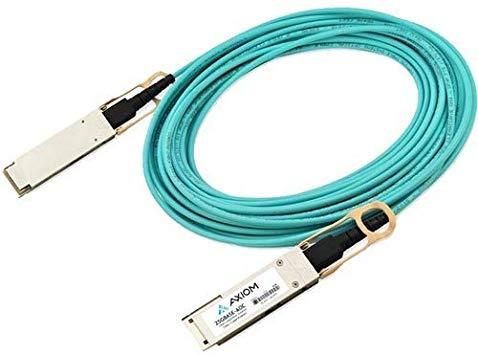
Features and benefits of Cisco 25G Modules
● Interoperable with other IEEE-compliant 25G interfaces where applicable
● Certified and tested on Cisco SFP28 ports for superior performance, quality, and reliability
● High-speed connectivity compliant to IEEE 802.3by and IEEE 802.3cc
The development of 25G SFP28 cable connections has provided a wide range of benefits, especially in a web-scale data center environment. Primarily, SFP28 cable is suitable for short-distance cabling of a network solution, which has a scientific layout design to save space with more reasonable length. It can efficiently utilize data and switch port density. Moreover, SFP28 cable provides an extremely efficient increase in speed to the server to TOR, especially when using the DAC assembly. It also simplifies the development of interoperability specifications and systems due to the fact that it is backward compatible and gives an easier upgrade path from an existing 10G TOR server configuration. Furthermore, using 25G SFP28 cables for TOR servers are more economical. This is because SFP28 cable can provide higher port densities, fewer TOR switches and cables are needed. It allows a more cost-effective alternative TOR server connection that connects via point-to-point links. It also enables EOR (End of Row) or MOR (Middle of Row) by using structured cabling.
Additional information
Are you looking for SFP28 DAC Cables and other fiber optics? As we know SFP28 DAC Cables is useful for short distance networking, so if you are searching for good quality DAC Cables then visit the web-address @ Gbic-shop.de.For more information about Cisco 25GBASE SFP28 optics and copper modules in details visit:- https://www.gbic-shop.de/SFP28-Direct-Attach-Kabel
References
https://www.unitymix.com/GBICSHOP
https://www.bagtheweb.com/b/9aAtvE
https://gbicshopde1.livejournal.com/843.html
https://dashburst.com/gbicshopde/9
https://list.ly/i/4421385
http://affiliated-business.com/story.php?title=buy-sfp56-direct-attach-kabel-from-our-online-web-address-gbic-shopde
https://www.worldranklist.com/preview/bookmarking/185646/Get-Reliable-Q28-502-transceiver-from-Gbic-shop-de-website
https://www.techsite.io/p/1383285
https://pr10.highdabookmarking.com/story.php?title=get-osfp-breakout-cables-from-gbic-shopde-at-low-price
http://www.ezyspot.com/node/411445
https://myspace.com/gbic.shop/mixes/streammix-724097/photo/373583067
https://gbicshopdethings.tumblr.com/post/190995788115/buy-sfp28-dac-cables-from-gbic-shopde
https://www.reddit.com/user/gbicshopde/comments/f8mzzc/get_high_performance_sfp28_dac_cables/
http://sco.lt/4hHYIK
http://www.pearltrees.com/gbic/item288859089
https://gbic.soup.io/
0 notes
Text
QSFP28 MSA Compatible 100G Optics Overview
As data centers around the world explore their options for increasing network speeds and bandwidth, 100G QSFP28 MSA compatible optics appear as an ideal alternative to accelerate data flow. QSFP28 optics hence become the universal data center form factor for 100G network transmission. This article will address QSFP28 MSA compatible optics used in 100G transmission.
QSFP28 MSA Optics: The Revolution in Data Centers
The adoption rate of QSFP28 MSA compliant optics is consistently on the rise for the past few years. It is predicted that over half of the data center will make the shift to adopting optics that is QSFP28 MSA compliant. The traditional 10G or even 40G may not be enough considering the explosion of data, therefore, QSFP28 MSA is going to become the new standard, and it has the following advantages.
Cost Efficiency—QSFP28 MSA optics now deliver a compelling price point, offering far greater capacity increases. And it still future-proofing the network with unsurpassed bandwidth. The growth in QSFP28 MSA optic deployments will undoubtedly drive down the cost of 100G optics.
Speed and Capacity—SFP+ and QSFP+ optics will not be enough for data intensive industries. Thus QSFP28 MSA optic is specifically designed to transport enormous amounts of data with ultra-low latency.
Flexibility—100G will be the preferred technology across long-haul networks. 100G networking can be customized, optimized, and easily expanded to allow for changes in the future.
QSFP28 MSA Compatible Optics Overview
QSFP28 MSA optic generally has the exact same footprint and faceplate density as 40G QSFP+ . But it is implemented with four 25-Gbps lanes. With an upgrade electrical interface, QSFP28 MSA optic is capable of supporting signal up to 28Gbps signals. Though QSFP28 transceiver keeps all of the physical dimensions of its predecessors, it surpasses them with the strong ability to increase density, decrease power consumption, and decrease price per bit. The Following are some QSFP28 MSA compliant optics for different applications.
100G SR4 QSFP28
100G SR4 QSFP28 is designed to support short distance transmission via multimode fiber. This transceiver module can support 100G transmission up to 70m on OM3 MMF and 100m on OM4 MMF. With MTP interface, the 100G SR4 QSFP28 MSA complaint module enables 4×25G dual way transmission over 8 fibers.
100G QSFP28 LR4
100G QSFP28 LR4 is QSFP28 MSA complaint, and is specifically designed for use in long distance transmission. QSFP28 LR4 utilizes WDM technology for 4×25G data transmission, and these four 25G optical signals are transmitted over four different wavelengths. With a duplex LC interface, 100G LR4 QSFP28 module enables 100G dual-way transmission up to 10 km over single-mode fiber.
QSFP28 100G PSM4
100G PSM4 is standardized by QSFP28 MSA and it uses four parallel fibers (lanes) operating in each direction, with each lane carrying a 25G optical transmission. 100G PSM4 module sends the signal down to eight-fiber cable with an MTP interface. The operating distance of 100G PSM4 is limited to 500 m.
QSFP28 100G DWDM4
100G DWDM4 uses WDM technology—an optical multiplexer and de-multiplexer to reduce the number of fibers to 2. Being QSFP28 MSA compatible, 100G DWDM4 can operate on single-mode fiber up to 2 km over duplex LC interface. Compared with QSFP28 LR4, it has shorter transmission distance and lower cost.
QSFP28 MSA Compliant Cables
In addition to the all the QSFP28 MSA 100G transceivers mentioned above, there are also high-speed cables deployed in 100G network. The cables can be either QSFP28 to 4 SFP28 copper cables (DACs), or active optical cables (AOCs). QSFP28 to 4 SFP28 DACs offer the lowest cost with reach up to 3 m. They are typically used within the racks of the data center, or as chassis-to-chassis interconnect in large switch and routers. QSFP28 AOCs are much lighter and offer longer reach up to over 100 m.
Conclusion
QSFP28 MSA compliant 100G optics are indispensable component to embrace 100G to your infrastructure, and they also facilitate scaling to 100G networks with the simplicity as 10G. With higher port density, lower power consumption and lower cost, QSFP28 MSA transceiver is an ideal alternative for large scale data centers, as well as for future network expansions.
1 note
·
View note
Text
Active Optical Cable & Extender Industry worth $6.2 billion by 2028
The report "Active Optical Cable & Extender Market by Product, Protocol (InfiniBand, Ethernet, Serial-Attached SCSI (SAS), DisplayPort, HDMI, Thunderbolt, USB), Form Factor (QSFP, QSFP-DD, SFP, SFP+, PCIE, CXP), Application and Region - Global Forecast to 2028" The active optical cable & extender market size is valued at USD 3.3 billion in 2023 and is anticipated to be USD 6.2 billion by 2028, growing at a CAGR of 13.1% from 2023 to 2028.
The key factors contributing to the growth of the active optical cable & extender market include the requirement for fiber optic modules in data centers and the large-scale adoption of cloud-based services. The acceptance of big data and analytics software is also a key factor driving the active optical cable & extender market. AOCs are deployed within data centers to optimize the existing infrastructure by providing higher data rates among servers, switches, and storage facilities. Cloud computing services require high bandwidth, processor speed, and I/O. Active optical cables are used for various cloud computing applications to meet these demands.
The extenders segment holds the second highest market share of the product segment.
Extender plays a crucial role in modern data transmission and telecommunications networks. As data rates and bandwidth demands continue to escalate, the need for reliable and high-speed connectivity over longer distances has become paramount. Extender addresses this requirement by utilizing optical fibers to transmit data signals over much greater distances than traditional copper cables. The extenders enable seamless communication between data centers, buildings, campuses, and across geographical locations, making them an essential component in an interconnected world.
InfiniBand to hold the largest share of the market in 2022.
InfiniBand is an industry-standard specification with a roadmap defining increasing speeds. It interconnects servers, communications infrastructure equipment, storage, and embedded systems. It provides switched, point-to-point channels with data transfers of up to 600 gigabits per second. Established and governed by the InfiniBand Trade Alliance (IBTA), InfiniBand technology is a prominent networking solution in supercomputer clusters. This technology has also become the preferred network interconnection method for GPU servers, particularly with the growing influence of AI applications.
QSFP-DD segment to exhibit second-highest CAGR between 2023 and 2028.
QSFP-DD (quad small form-factor pluggable double density) is a transceiver module designed to meet the escalating demand for high-speed data transmission in modern networking and data communication environments. The QSFP-DD module incorporates more electrical lanes and higher data rates than QSFP28. This module leverages eight lanes capable of supporting data rates of 25 Gbps or 50 Gbps, resulting in an aggregate data rate of up to 400 Gbps. This significant enhancement in data capacity positions QSFP-DD as an ideal solution for bandwidth-intensive applications, such as cloud computing, data centers, and emerging technologies, including 5G networks and artificial intelligence.
North America to hold the second-largest share of the active optical cable & extender market during the forecast period.
In North America, AOCs and extender cables are widely used for various applications, including data centers, energy, and telecommunications, to provide advanced connectivity solutions. AOCs are vital conduits for high-speed data transmission, enabling fast communication and efficient networking in sectors such as telecommunications and data centers. They support the growing demand for fast and reliable internet connectivity, facilitating seamless video streaming, online gaming, and business operations.
On the other hand, extender cables are crucial in sectors such as manufacturing and energy, where they bridge communication gaps between remote equipment and control centers. They facilitate efficient data transmission from renewable energy sources and bolster security and surveillance systems in critical infrastructure protection and defense. As North America continues to drive technological innovation, AOCs and extender cables are pivotal in enhancing connectivity and data transmission, contributing to the region’s economic growth and technological advancement. Moreover, top active optical cable companies, such as Broadcom (US), 3M (US), Coherent Corp (US), and Corning Incorporated (US), are headquartered in North America.
Download PDF Brochure: https://www.marketsandmarkets.com/pdfdownloadNew.asp?id=138597811
Coherent Corp.(US), Broadcom (US), Amphenol Communications Solutions (US), Corning Incorporated (US), TE Connectivity (Switzerland), 3M (US), Molex (US), Sumitomo Electric Industries Ltd.(Japan), Dell Inc.(US), Eaton (Ireland), EverPro Technology Co., Ltd. (China), Alysium-Tech GmbH (US), Mobix Labs Inc. (US), Unixtar Technology, Inc. (Taiwan), IOI Technology Corporation (Taiwan), GIGALIGHT (China), Siemon(US), Koincable (China), Black Box (US), ATEN INTERNATIONAL Co., Ltd. (Taiwan), T&S Communication Co, Ltd. (China), ACT(Netherlands), APAC Opto Electronics Inc. (Taiwan), Shenzhen Sopto Technology Co., Ltd., (China), Anfkom Telecom (China), Extron (US), and Roctest (Canada) are the major players in active optical cable & extender market. These players have implemented various strategies to extend their global reach and enhance their market share.
About MarketsandMarkets™
MarketsandMarkets™ is a blue ocean alternative in growth consulting and program management, leveraging a man-machine offering to drive supernormal growth for progressive organizations in the B2B space. We have the widest lens on emerging technologies, making us proficient in co-creating supernormal growth for clients.
The B2B economy is witnessing the emergence of $25 trillion of new revenue streams that are substituting existing revenue streams in this decade alone. We work with clients on growth programs, helping them monetize this $25 trillion opportunity through our service lines - TAM Expansion, Go-to-Market (GTM) Strategy to Execution, Market Share Gain, Account Enablement, and Thought Leadership Marketing.
Built on the 'GIVE Growth' principle, we work with several Forbes Global 2000 B2B companies - helping them stay relevant in a disruptive ecosystem.Our insights and strategies are molded by our industry experts, cutting-edge AI-powered Market Intelligence Cloud, and years of research.The KnowledgeStore™ (our Market Intelligence Cloud) integrates our research, facilitates an analysis of interconnections through a set of applications, helping clients look at the entire ecosystem and understand the revenue shifts happening in their industry.
To find out more, visit www.MarketsandMarkets™.com or follow us on Twitter, LinkedIn and Facebook.
0 notes
Text
Cabling Implementation in QSFP Connectors
Cabling Implementation in QSFP Connectors
Quad Small Form-factor or QSFP cable IO interface interconnects have traditionally been made up of pluggable connectors and wires. The four-lane design is often used to link server, storage, switch, video, and communication systems. Cloud data centers, business data centers, HPC (high-performance computing) laboratories, video surveillance systems, Internet provider systems, and machine vision…
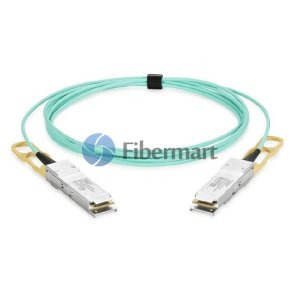
View On WordPress
0 notes
Text
Direct Attach Cable VS. Active Optical Cable
Direct attach cable (DAC) and active optical cable (AOC) is crucial high-speed interconnect cabling solutions in data centers and high-performance computing applications. DAC and AOC cables are plug-and-play, allowing the users to optimize the existing network without new optical fiber cabling. This article will discuss the differences between DAC and AOC cables.
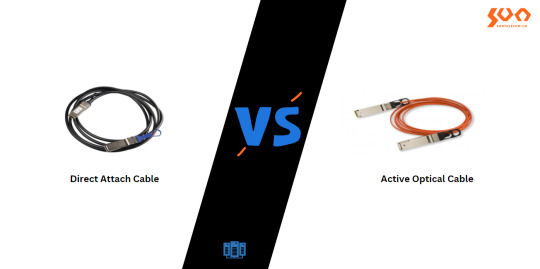
DAC Cable VS. AOC Cable
DAC cable consists of a Twinax copper cable terminated with SFP+/SFP28/QSFP+/QSFP56/QSFP28 connectors on both ends, which can provide an electrical connection directly to active equipment. DAC cable can be passive or active. Passive and active DAC cables can transmit electrical signals directly over copper cables. The passive DAC cable can deliver without signal conditioning, while the active DAC cable has electric components inside the transceivers to boost signals. AOC cable consists of a multi-mode fiber optic cable terminated with SFP connectors on both ends, which requires external power to complete the conversion of electric and optical signals, from electric signals to optical ones, and then convert to electric signals finally.
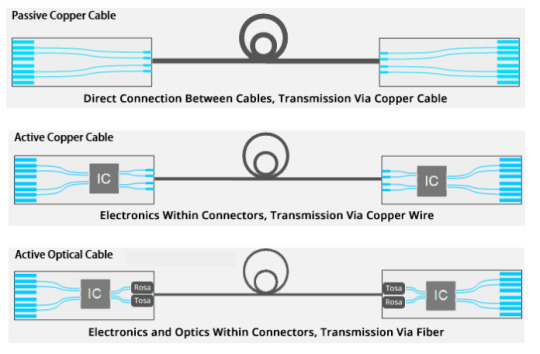
DAC and AOC cables differ from each other in the following aspects :
1. Power Consumption
Usually, the power consumption of an AOC cable is higher than a DAC cable, which is 1-2w. While the power consumption of active DAC cables is less than 1w, and the passive DAC cables cost nearly no power consumption at the value of lower than 0.15w due to the thermal design of DAC cables. As a result, the operating expenses on power consumption will be decreased when adopting the DAC options.
2. Transmission Distance
AOC cable can transmit over longer distances up to 100 m, while DAC cable link length limit is 10 m (passive DAC: 7 m; active DAC: 10 m). To sum up, DAC cable is suitable for short-range transmissions, while AOC cable is used for long-range transmissions.
Note: the max. distance of a signal that can be transmitted via a DAC cable changes depending on the data rate. The link length will decrease as the data rate grows, for example, 100G DAC cables can only transmit up to 5 meters.
3. Cost
In general, copper cables are much cheaper than fiber cables. When implemented in the high-density data center, the sum of money will be saved for large quantities of DAC cable compared to AOC cable.
4. Electromagnetic Interference Immunity
AOC cable is immune to electromagnetic interference, while DAC cable is vulnerable to the effect of electromagnetic interference, such as unwanted responses, degradation, or complete system failure.
5. Application
DAC cable is used to connect switches/servers to switches within racks and adjacent racks. In other words, DAC cable is used as an alternative for ToR (top of rack) interconnections between the ToR switch and server or the stacking of switches.

AOC Cable is used to connect ToR switches to EoR (end-of-row) aggregation switches, and to connect the ToR switch with MoR (middle-of-row) storage subsystems at reaches greater than DAC cable limits of 3-7 meters.

Conclusion
DAC and AOC cables are simple, cost-effective cabling solutions that are designed for the same ports as SFP+ or QSFP transceivers. DAC cable use copper-based cabling while AOC cable use fiber-based cabling. DAC cable provides lower power consumption and is cheaper than AOC cable. However, AOC cable provides long transmission distances than DAC cable. Sun Telecom specializes in providing one-stop total fiber optic solutions for all fiber optic application industries worldwide. Contact us if any needs.
1 note
·
View note
Text
25GbE Ethernet and 25GbE Products FAQs
25GbE Ethernet has been an eye-catching topic ever since its introduction in 2016. After its appearance, the upgrade path to 100G has a new option — 10G-25G-100G. Although 25G has already been released, it’s still a new thing for many people. Here collect some common questions which will help you to better know 25GbE Ethernet and 25GbE Products.

25GbE Ethernet FAQs
What is 25GbE Ethernet?
25GbE Ethernet is a standard for Ethernet connectivity that benefits cloud and enterprise data center environments. It uses technology defined for 100GbE Ethernet, which implemented as four 25 Gbit/s lanes running on four fibers or copper pairs.
25GbE VS 10GbE, which is better?
As data centers require faster speed and higher bandwidth, 10GbE is not fast enough for switch-server connections. 25GbE was proposed to provide 2.5 times the performance of 10GbE as well as offers higher bandwidth at the same power consumption. 25GbE Ethernet supports 10GbE technology advancements in packaging and silicon. All these benefits contribute the existing switch architectures to supporting link speeds faster than 10GbE without the need to add cable/trace interconnects. At the same time, the architectures can keep up with the growth of the network bandwidth and become faster and richer.
25GbE VS 40GbE, who is the winner?
Compared to 40GbE, 25GbE can provide a higher port density with maximum switch I/O performance and fabric capability, enabling the network bandwidth to be effectively scaled in cloud and web-scale data center environments. What’s more, the 25G-100G (4x25G lanes) networking migration path provides a lower cost per unit of bandwidth by fully utilizing switch port capabilities when compared to 40G-100G upgrade path.
What makes 25GbE a choice for next-generation switch-server connections?
25GbE technology has two major advantages. First, by offering a single-lane 25Gbps variant, 25GbE allows for optimization of the bandwidth available from switch-fabric design, which is typically viewed from a per-pin and therefore per-lane standpoint. Another major advantage is that it takes existing module form factors and optical plants factors, such as SFP28 and QSFP28, and allows for a breakout connection that is configurable as either 25GbE per lane or the full 100GbE without changing the port on the front of switches and the wholes physical infrastructure.
Will the upgrade path of 100GbE be 10G-25G-100G?
Before the 25GbE specification was released, the 10G-40G-100G upgrade path is predominantly adopted by data centers to upgrade to 100GbE. However, due to the appearance of 25GbE, the 10G-25G-100G upgrade path has gained more recognition by offering the cost per bit, power consumption and server rack density advantages. 25GbE provides another option for 100GbE upgrade, and its prospect is bright.

25GbE Products FAQs
What kinds of 25GbE products are on the market today?
Currently, 25GbE products on the market are relatively complete. These 25GbE switch, 25GbE NIC, 25GbE SFP28, 25GbE DAC/AOC cable are all available on the market.

What does SFP28 stand for?
SFP28 is the enhanced version of SFP+, designed for 25G signal transmission. It has the same physical structure as SFP and SFP+, but its electrical interface is upgraded to handle 25Gbps per lane. The pinouts of SFP28 and SFP+ connectors are compatible. Compared to SFP+ solution, SFP28 has higher bandwidth, superior impedance control, and less crosstalk. In addition, the SFP28 copper cable has greater bandwidth and lower loss than the SFP+ version.
Can SFP28 cables be plugged into SFP+ ports?
Yes. SFP28 is backward compatible with SFP+ ports and can work sufficiently. SFP+ cables can be plugged into SFP28 ports but they are not designed for 25Gb/s data rates.
Can 10G SFP+ and 1G SFP transceivers be plugged into the associated 25G SFP ports?
Yes. The associated 25G SFP ports can run multiple speeds and support 10G SFP+ and 1G SFP transceivers. However, some port level restrictions may occur during speed mixing and matching.
Are branded 25G transceivers interoperable with third-party 25G transceivers?
Yes. Third-party 25G transceivers are compliant with relevant industry standard specifications and can be fully interoperable as long as compatibility is guaranteed.
Where can customers buy split cables for 100G to 4x25G connectivity?
Large vendors can supply volumes of MTP-LC multimode fiber breakout cables to customers for 100G to 4x25G connectivity. FS also provides 100G QSFP28 to 4x25G SFP28 DAC/AOC cables for you to choose.
Summary
25GbE Ethernet is considered an incremental update of 10GbE Ethernet, which supports 100GbE Ethernet with single lane at 25Gbps. Due to the booming of 25GbE, data centers will gradually turn to 25GbE networks. Knowing the above information is essential for you to deploy 25GbE Ethernet networks and avoid some problems when purchasing 25GbE products. FS offers a wide variety of high-quality and cost-effective 25GbE Ethernet portfolios such as 25gbe switch, 25G NIC, 25G SFP28 transceiver, and 25G DAC/AOC cables to meet your needs of 25GbE devices and connectivity options.
Original Source:
http://www.fiber-optical-networking.com/25gbe-ethernet-and-25gbe-products-faqs.html
0 notes